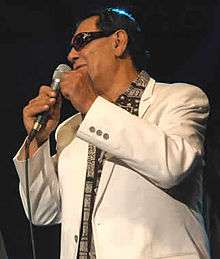Romani people in Serbia
| ||||
| Total population | ||||
|---|---|---|---|---|
| (147,604 (2011)) | ||||
| Languages | ||||
| Romani, Serbian | ||||
| Religion | ||||
|
| ||||
| Part of a series on |
| Romani people |
|---|
|
Diaspora
|
|
Romani people (Serbian: Роми, Romi) are one of the three largest ethnic minorities in Serbia, along with the Hungarians and Bosniaks. Another name used for Roma in Serbia, often with a negative connotation, is Cigani (Serbian: Цигани, from Greek Tsinganoi).
History
Middle Ages
The first reference to the Romani people in Serbia is found in a 1348 document, by which Stefan Uroš IV Dušan of Serbia, Emperor of Serbs and Greeks donated some "Gypsy" slaves to the Monastery of Prizren, in Kosovo.[1]
Demographics
There are 147,604 Romani people in Serbia, but unofficial estimates put the figure up to 450,000-500,000.[2] Between 23,000-50,000 Serbian Roma are internally displaced persons from Kosovo.[3]
| Census | Population |
|---|---|
| 1866 | 24,607 |
| 1895 | 46,000 |
| 1948 | 52,181 |
| 1953 | 58,800 |
| 1961 | 9,826 |
| 1971 | 49,894 |
| 1981 | 110,959 |
| 1991 | 94,492 |
| 2002 | 108,193 |
| 2011 | 147,604 |

The Romani people in Central Serbia are predominantly Serbian Orthodox but a minority of Muslim Roma exists (mostly Roma refugees from Kosovo), mainly in the southern Serbia.
Romani people in multi-ethnic Vojvodina are integrated with other ethnic groups, especially with Serbs, Romanians and Hungarians. For this reason, depending of the group with which they are integrated, Romani are usually referred to as Serbian Romani, Romanian Romani, Hungarian Romani, etc.
Culture
The majority of Romani people are Christian and a minority are Muslim. Đurđevdan or Ederlezi is a traditional festivity of Roma in Serbia. They speak mainly Romani and Serbian. Some also speak the language of other people they have been influenced by: Romanian, Hungarian or Albanian. In October 2005 the first text on the grammar of the Romani language in Serbia was published by linguist Rajko Đurić, titled "Gramatika e Rromane čhibaki - Граматика ромског језика".
Discrimination
A large number of Serbian Roma people live in slums, and so-called "cardboard cities". Many Roma children never go to school. Instead they are often used as beggars, occasionally even mutilated in order to earn more money.
On 3rd April 2009, a group of Romani people who had been living in an unlawful settlement in Novi Beograd were evicted on the orders of the mayor of Belgrade.
According to the press, bulldozers accompanied by police officers arrived to clear the site early in the morning before the formal eviction notice was presented to the community. The makeshift dwellings were torn apart while their former occupants watched.
The site was cleared in order to make way for an access road to the site of the 2009 Student Games, to be held in Belgrade later this year.
Temporary alternative accommodation in the form of containers had apparently been provided by the Mayor of Belgrade, but some 50 residents of the suburb where they had been located attempted to set fire to three of the containers. Many of the evicted Roma have spent five nights sleeping in the open in the absence of any alternative accommodation.[4] Physical violence against Roma is also common, most notably by Rad United Force supporters. Thirteen-year-old Dusan Jovanović was attacked in the center of Belgrade in the evening of 18th October 1997 as he was returning home from a store. He was attacked by 4 underage skinheads. They attacked him in front of house he lived with his family. They kicked him until death. This murder took place in very hostile environment, at the time when all around Serbia, many Roma's were brutally beaten by racist groups. The government never did anything to address these issues. Only two of his 4 attackers were arrested, and they received highest sentence available, of 10 years in prison, but were released after serving only six.[5]
Part of these attacks was murder of Dragan Maksimović, Serbian actor.
Political parties
Notable people
- Trifun Dimić, romologist.
- Dr. Rajko Đurić, professor, journalist, and politician.
- Srđan Šajn, politician.
- Bakija Bakić, a famous trumpet musician
- Janika Balaž, a famous tamburitza musician.
- Džej Ramadanovski, folk singer
- Boža Nikolić, folk singer
- Sinan Sakić, folk singer
- Ljuba Aličić, folk singer
- Šaban Bajramović, famous folk/jazz singer
- Usnija Redžepova, folk singer
- Predrag Luka, footballer
- Dejan Osmanović, footballer
References
- ↑ Djordjević , T.R. (1924). Iz Srbije Kneza Milosa. Stanovnistvo—naselja. Beograd: Geca Kon.
- ↑ (World Bank, 2005b; Antic, 2005)
- ↑ http://www.osce.org/odihr/39623?download=true
- ↑ http://www.amnesty.org/en/news-and-updates/feature-stories/europes-roma-community-still-facing-massive-discrimination-20090408#serbia
- ↑ http://www.e-novine.com/mobile/srbija/srbija-tema/73056-Smrt-dravi-nasilja.html
Further reading
- Dr. Rajko Đurić, Istorija Roma, Beograd, 2006.
External links
| ||||||||||||||||||||
| |||||||||||||



